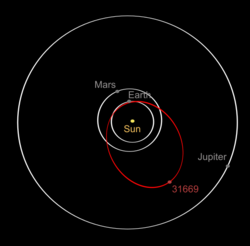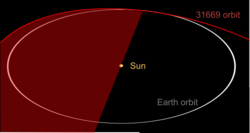Astronomy:(31669) 1999 JT6
| Discovery[1] | |
|---|---|
| Discovered by | LINEAR |
| Discovery site | Lincoln Lab's ETS |
| Discovery date | 12 May 1999 |
| Designations | |
| (31669) 1999 JT6 | |
| Minor planet category | NEO · Apollo · PHA |
| Orbital characteristics[1] | |
| Epoch 13 January 2016 (JD 2457400.5) | |
| Uncertainty parameter 0 | |
| Observation arc | 5209 days (14.26 yr) |
| |{{{apsis}}}|helion}} | 3.3709 astronomical unit|AU (504.28 Gm) |
| |{{{apsis}}}|helion}} | 0.90316 AU (135.111 Gm) |
| 2.1370 AU (319.69 Gm) | |
| Eccentricity | 0.57737 |
| Orbital period | 3.12 yr (1141.1 d) |
| Average Orbital speed | .3158 deg/day |
| Mean anomaly | 167.37° |
| Mean motion | 0° 18m 55.8s / day |
| Inclination | 9.5420° |
| Longitude of ascending node | 78.848° |
| 39.099° | |
| Earth MOID | 0.000613623 AU (91,796.7 km) |
| Physical characteristics | |
| Rotation period | 5.807 h (0.2420 d) |
| Absolute magnitude (H) | 16.0 |
(31669) 1999 JT6 is an Earth-crossing asteroid belonging to the Apollo family of asteroids which also crosses the orbit of Mars. 1999 JT6 is the asteroid's temporary discovery name. It has now been assigned a permanent number from the Minor Planet Center (31669) indicating that its orbit has been confirmed, but has not (at least so far) been assigned a name. Only a small fraction of asteroids have been named.
It has an Earth minimum orbit intersection distance of 0.00354 AU (328,978 miles), which is close enough to classify it as a potentially hazardous asteroid (PHA). It will make a close approach to Earth on 14 December 2076 at 0.0260 AU (2,506,321 miles) and an even closer approach to the minor planet Ceres on 16 Feb 2084 at 0.0171 AU (1,587,064 miles).
References
External links
- (31669) 1999 JT6 at NeoDyS-2, Near Earth Objects—Dynamic Site
- Ephemeris · Obs prediction · Orbital info · MOID · Proper elements · Obs info · Close · Physical info · NEOCC
- (31669) 1999 JT6 at ESA–space situational awareness
- (31669) 1999 JT6 at the JPL Small-Body Database
 |



